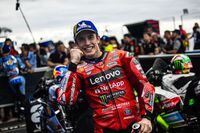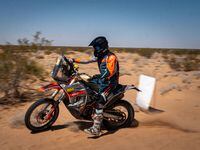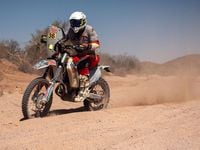Three things stand out from this Grand Prix:
- The dominance of Ducati: filling the top five places.
- The presence of the Márquez brothers: Marc and Álex, first and second. How did Marc fight through years of problems to earn his way back onto the top factory seat, and be his old self? How did Álex, presumably stultified by his years of midfielding, bloom as he has?
- Returns to competitiveness: By Honda and Johann Zarco in sixth place, showing strong recovery from near-nonexistence. By Franco Morbidelli in third, having come to MotoGP in sweet promise, only to suffer soul-crushing reverses. He lives!
The race described in short: Marc first away; a turn 1 error by Marc put Álex in the lead, where by small fractions of a second he stayed. Then Marc’s failed pass attempt on L18: another error. The next lap, Marc was past and so it remained.
What was remarkable was how hard the brothers pushed each other. It takes some doing to force Marc Márquez into errors that take serious time to recoup. This bodes well!
Following Álex, Marc did as he has done so many times: push while somehow economizing on tires, knowing that his opponent, some 0.3 second ahead, is steadily losing grip. When the moment comes, it is grip versus less grip, and the outcome is decided.
Related: MotoGP: Origins Of Style, Part 1
Despite all the above, many race watchers are announcing they are bored. Ducati dominance means the end of sport. Márquez dominance means the end of sport. Hyperbole or just the usual fan take on dominance?
OK, a bit of history. The excellence of Kenny Roberts in 1978 came in large part from his ability to steer with the rear when he couldn’t steer with the front. He knew that the strength of powerful bikes was acceleration, and that their weakness was turning. So, in contrast to the Europeans, sailing through corners at high speed on their “great circle route,” he braked to a lesser speed, got his bike turned early, then used the rest of the corner for acceleration. In those days there were no show managers training team members to keep the grandstands shouting by forming a circle, then hopping up and down like ballplayers. Kenny’s ability to win races by being good at racing earned him the derisive title “Kenny Robot.”
They didn’t feel warm and cuddly about Mick Doohan’s excellence either. Five titles in a row? A scandal! One onlooker proposed he “…slow down and make a race of it.” Suzuki couldn’t really afford MotoGP despite Kevin Schwantz’s great ability, and Yamaha had a different problem with rider excellence: Wayne Rainey, I was told by a Yamaha engineer in 2003, could ride anything to a good lap time. Anything. When asked what needed improving, he couldn’t really say.
Valentino Rossi took note, and stocked up on cleverly worded flags, inflatable dolls, and other after-the-flag amusements that kept spectators on his side despite his excellence. He fenced with rivals in every way. Clever management! When I asked his crew chief, Jeremy Burgess, how there could be time in a race weekend to get all the normal settings plus the new electronic systems right, he said, “It helps if your rider is highly intelligent.”
The dominant rider in any era is the one who has an insight no other rider has. Marc’s education was in Moto2, where spec engines and Kalex chassis denied the teams any equipment advantages. Where does that leave the rider? All racers know that tire grip changes during a race. At the start, with the heat distribution given them by the warmers, the tires are odd, making the first laps tricky. Yet some, like Casey Stoner, could make distance by understanding and somehow exploiting cold-tire behavior. So many riders, postrace, announce that they had no rear grip, or no front grip, or no grip on the left side.
Marc studied to good effect. In his first MotoGP year, in Germany, it was possible to see the step in lap time indicating tire drop had occurred. Márquez, the newcomer, went 18 laps to tire drop, while Rossi went eight and Jorge Lorenzo 12.
It was wonderful to see Rossi in his years of dominance, somehow leading without spinning or sliding. The farther downfield you looked, the more spinning and sliding you saw. Draw a conclusion.
How can you tell when a rider is taking a risk? You see slips, bobbles, “moments” as a sliding bike requires recovery. If you take care always to have more tire than your opponent, you’re in with a chance.
The prospect of Ducati/Márquez dominance has many people investigating alternatives such as celebrity mud-wrestling or those East Europe real estate shows. But let’s have a look at what Ducati has done. Let’s investigate its excellence as well as that of its riders.
Remember “The Aliens”? They were the supposed super-riders, greater than which nothing could be conceived: Rossi, Lorenzo, Dani Pedrosa. But when Dorna imposed a spec ECU, running simplified spec software, it turned out the “Aliens” were actually the software writers and their laptops, working at long tables in the first room behind each factory team’s box. They were creating wonderful things like Andrea Zugna’s “mu-learning,” using anti-spin cycles to measure grip, then pairing those measurements with GPS coordinates to make traction maps of the racing line at every circuit.
Time was required to get up to speed on obsolete spec software, but as before, each factory team was building its bike around the riding style of their top rider, others be damned, and they were—we saw it. This worked superbly for Honda and Marc Márquez. Also for Yamaha and Fabio Quartararo—for a time.
After two championship seconds for Ducati’s Andrea Dovizioso, Ducati evidently decided to turn the “key-man” concept on its head by creating a key bike, making many of them, and then putting the strongest Moto2 grads on them. No more fitting a single bike to a single rider. Instead, the new lads would learn MotoGP on a machine created by deliberate attempt to alloy the dominant point-and-shoot style with enough corner-speed ability to put an end to the old “Honda track, Yamaha track” dichotomy. Ducati’s new motorcycle would try to do it all well, not just do half the corners superlatively.
Further, having eight bikes and riders on the track would reveal the talent while gathering data at an unprecedented rate.
The 2024 season’s powerful Bagnaia/Martín contest was the result. Great racing. When Marc Márquez had shown he was both returning to himself and mastering the Ducati, the Red Team had to have him because what if somebody else did? If he wins races, great, and if he doesn’t, at least he’s not on another brand, making trouble for Francesco Bagnaia & Co. And so their fresh new No. 1, Jorge Martín, was “released to pursue other career opportunities.”
I’m sorry that Martín is parked with injuries, but that happens in this game. He’ll return, looking wounded, but will exert the self-discipline he showed in 2024 and be back.
The prospect of great racing between the Márquez brothers is delightful. Can Honda, KTM, or Aprilia drill holes in Ducati dominance? We’ve already seen the Márquez brothers suddenly become the lead act. We see Zarco, for once having great things to report as his Honda carried him within sight of the Red action. Does Honda have resources to burn? Does it snap up the top engineering grads of Tokyo University? Does it have a history of success, hard-won? Ducati knows Honda is coming.
Sadly, the Yamaha remains where it’s been for five years: short of rear grip. Is this a mystery, or would increased weight transfer (hard to do or impossible with a long and low corner-speed ride) get that back tire speaking the language? Five years with no rear grip is radical. A radical response is called for.
KTM and Aprilia have had their moments. What if one or both remanufactures itself as Ducati has done? I want to see.
This has the ingredients of a grand season.

















/cloudfront-us-east-1.images.arcpublishing.com/octane/K5FNV7ONUVDXJJ2H5BIWUGBGTI.jpg)
/cloudfront-us-east-1.images.arcpublishing.com/octane/MGVKP5VTNJHQ7FWNAHIWX4OHO4.jpg)
/cloudfront-us-east-1.images.arcpublishing.com/octane/6JEYTSIZQRHPJAVVPRLWZU63UM.jpg)
/cloudfront-us-east-1.images.arcpublishing.com/octane/XJU3VJZSDFEOVDBJTRXTTLTN5U.jpg)

/cloudfront-us-east-1.images.arcpublishing.com/octane/A6O3TEZF45BVFG2KKOUMPWEYM4.jpg)
/cloudfront-us-east-1.images.arcpublishing.com/octane/MHVFMH2YN5DT3EOZPLXKNFP3VM.jpg)
/cloudfront-us-east-1.images.arcpublishing.com/octane/VILA5L7CTBGOJGDKM2YAOCR6VU.jpg)
/cloudfront-us-east-1.images.arcpublishing.com/octane/GZMZRTYRS5A75G2EJDDGXLJEEE.jpg)
/cloudfront-us-east-1.images.arcpublishing.com/octane/6KWAL3TFNJBGTJMJSKQ2C6I3IY.jpg)
/cloudfront-us-east-1.images.arcpublishing.com/octane/GK5I5R3X7JCABGCKAKT4XY2K7U.jpg)


/cloudfront-us-east-1.images.arcpublishing.com/octane/RGUT3Y65IFGDFMLHQ3U7G5UUQE.jpg)

/cloudfront-us-east-1.images.arcpublishing.com/octane/37CSHD6CKRHYXHRB67EOLDS6XM.jpg)
/cloudfront-us-east-1.images.arcpublishing.com/octane/FYB7GKDGLVE3JKXMM75JTG2RYA.jpg)
/cloudfront-us-east-1.images.arcpublishing.com/octane/3ECVMM622VAZHIOLI6Q6ILWULU.jpg)


/cloudfront-us-east-1.images.arcpublishing.com/octane/UIZQ7VXRCRHBVDFK5RFJIEBBAU.jpg)

/cloudfront-us-east-1.images.arcpublishing.com/octane/QXBJ4CVEEBG2BF5O3TOPIGP7ZE.jpg)
